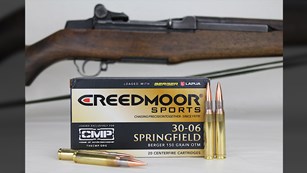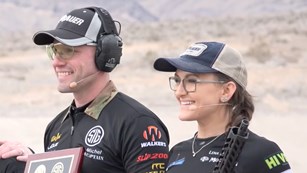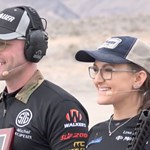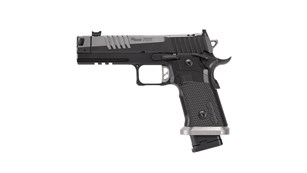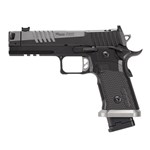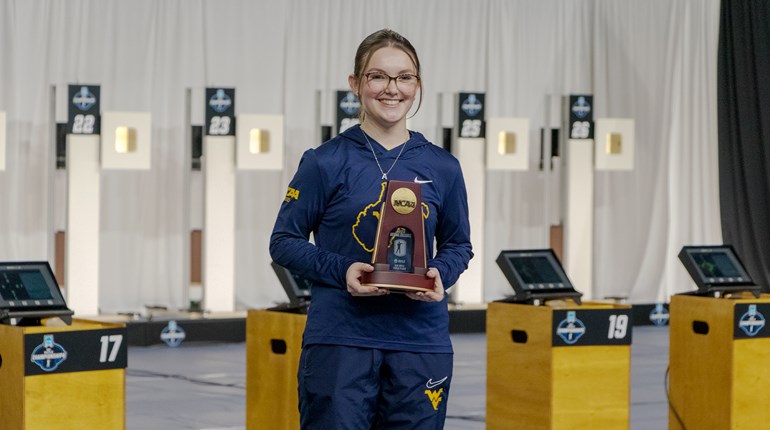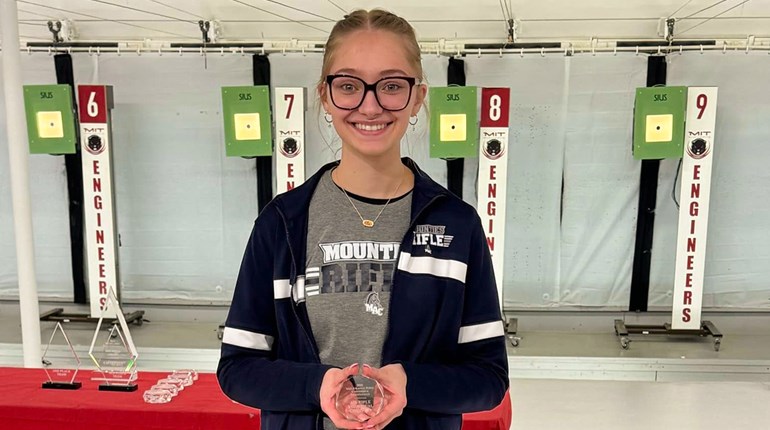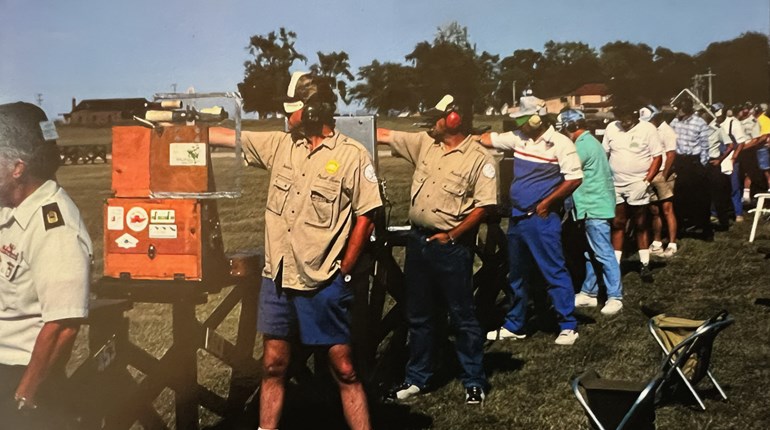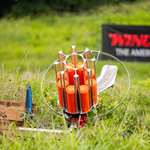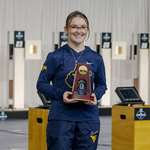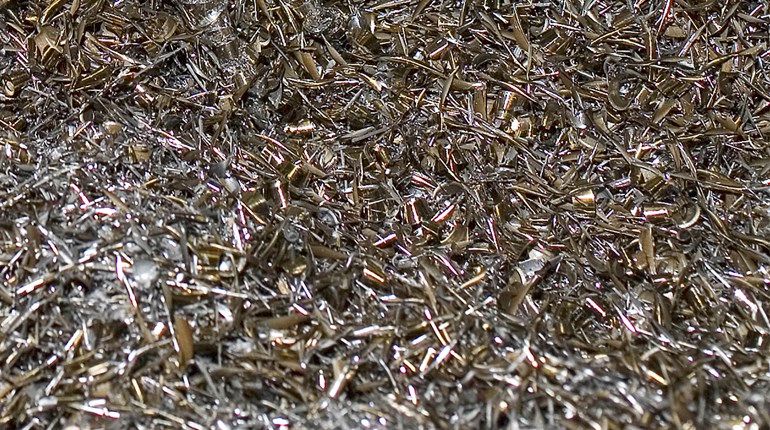
Those who passed through the gates of Camp Perry in the summer of 1985 saw dramatic changes as the result of Ohio’s Capital Improvement Development Grant. Most noticeable was in the competitor housing area, where nearly half of the distinctive World War II hutments were replaced with 64 air-conditioned modular units. (There were approximately 500 huts remaining after this summer. Originally, about 2,000 were built during the war. This was not the first time huts had been razed. Earlier this decade, several rows were demolished to make way for barracks.)

A special ribbon cutting ceremony was held to commemorate the renovation at the beginning of a National Match program where pleasant weather days outnumbered the poor—an occurrence always welcomed but never guaranteed on the fickle Lake Erie shoreline.
“Unprecedented interest filled the vast Lake Erie range to capacity during some of the month-long competition.”
—The American Rifleman, October 1985
When fine conditions prevailed, so did equally fine scores among the nearly 4,000 competitors. Civilians finished on top in three of the four major title races and one of its newest class members was national pistol champion Max Barrington, who was just months removed from a career in the Army.
Perhaps the change of pace is just what Barrington needed, for despite vying for the title in 1983 and 1984, his chances were dashed both years during the .45 stage. In 1984, after pointing his short-barreled Smith & Wesson 41 to victory in the opening .22 Championship with a score six Xs off Hershel Anderson’s 1974 record of 894-58X, Barrington fired his Colt 1911A for a 872-39X center-fire aggregate and entered the .45 competition three points down to Army Reservist Norm Girardin. The final result, however, was markedly different for Barrington this time around as he pulled ahead for the aggregate win with an 884 and secured the overall title with a 2650-133X, nine points better than Girardin’s second-place finish.
Ruby Fox returned to Camp Perry in 1984 to collect her seventh women’s title and Joe White, whose National Match career started as a member of the U.S. Border Patrol team in the 1950s, successfully defended his 1984 senior crown. Civilian Ed Williams won the National Trophy Individual Match while Staff Sgt. Sumter Nelson earned the President’s Trophy plaque and congratulatory letter from President Ronald Reagan.
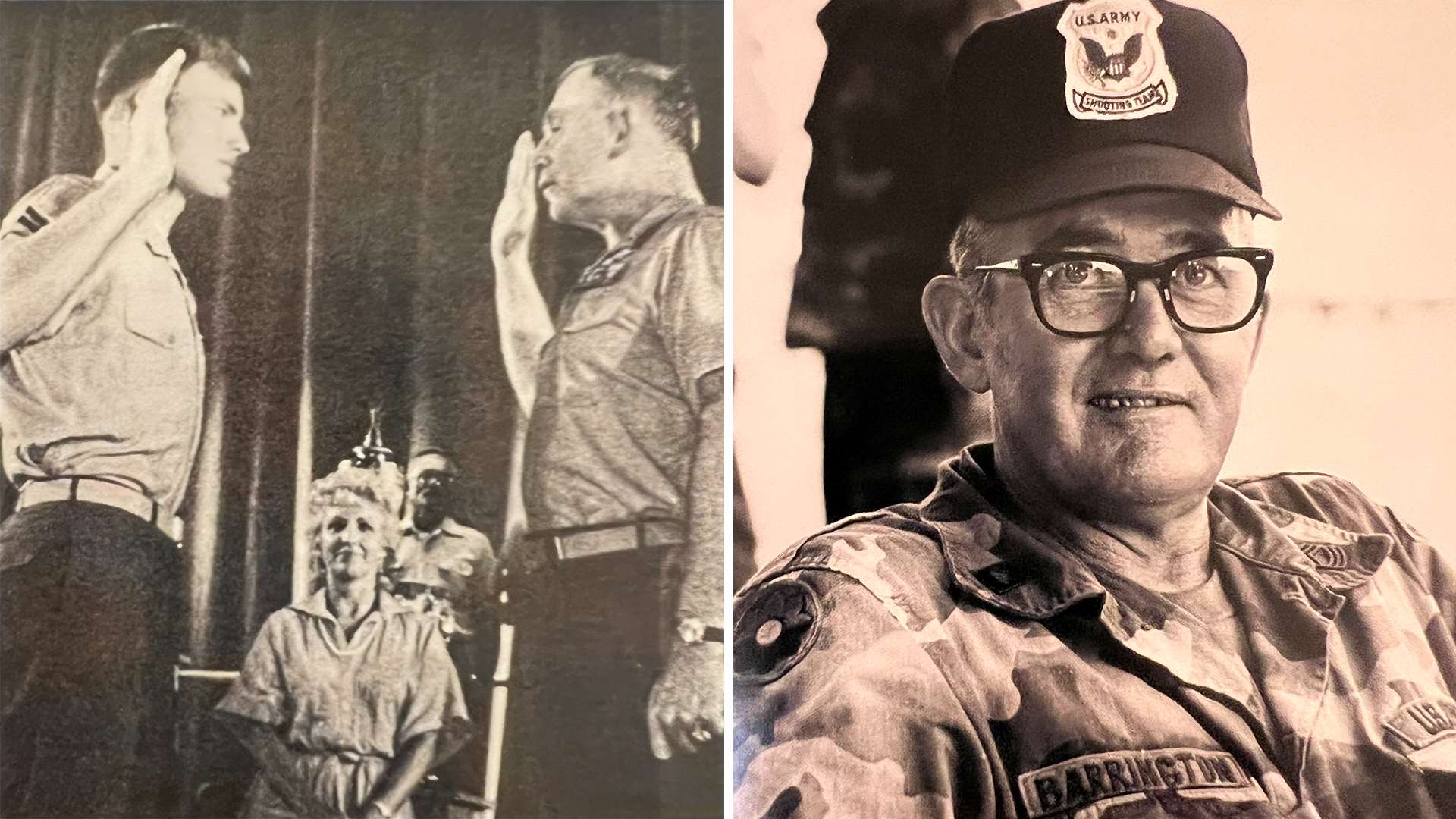
The U.S. Army Blue unit garnered the National Trophy Team event one day after locking up the NRA Pistol Team Aggregate and for Tom Woods, who fired on both winning teams, it was a foreshadowing of things to come on the individual front. This year he finished third overall after runner-up performances in both 1983 and 1984, but his next National Match appearance would prove to be the charm.
Carl Bernosky’s championship reputation was already well documented at this point in National Match history by virtue of his unprecedented four consecutive high power titles from 1977 through 1980. So, when Bernosky switched to smallbore position in search of more competitive opportunities at the international level, success followed the fine young talent from Pennsylvania to the Camp Perry firing line—in a big way.
Not only did Bernosky, in just his second smallbore trip to Perry, snap the nine-year consecutive win streak of Lones Wigger, Jr., he became the first civilian to win the national position championship and third shooter in National Match history, joining Gary Anderson and D.I. Boyd, to win both high power and smallbore titles. (Gary Anderson won the smallbore position title in 1967 and high power titles in 1975 and 1976. D.I. Boyd won his smallbore position and high power titles in 1972 and 1981, respectively.)
Bernosky started off in a less than auspicious manner by firing a 393 prone, but he quickly pulled himself together to win the standing and kneeling matches for the metallic sight championship. Wigger came out hard on the second day but fell early to Suzanne Mitchell’s winning prone score of 400. In offhand he had no equal and then placed second in kneeling to George Metz, earning the any sight championship for his consistent performance.
Though Wigger’s effort was not good enough for the overall title, he did keep his consecutive service championship streak alive at 10 with his 2279 score. Bernosky squeezed 10 more points out of his custom-barreled Anschutz 1813 to earn his first smallbore championship with a 2289, still well below the record 2316 that Wigger fired three years earlier.
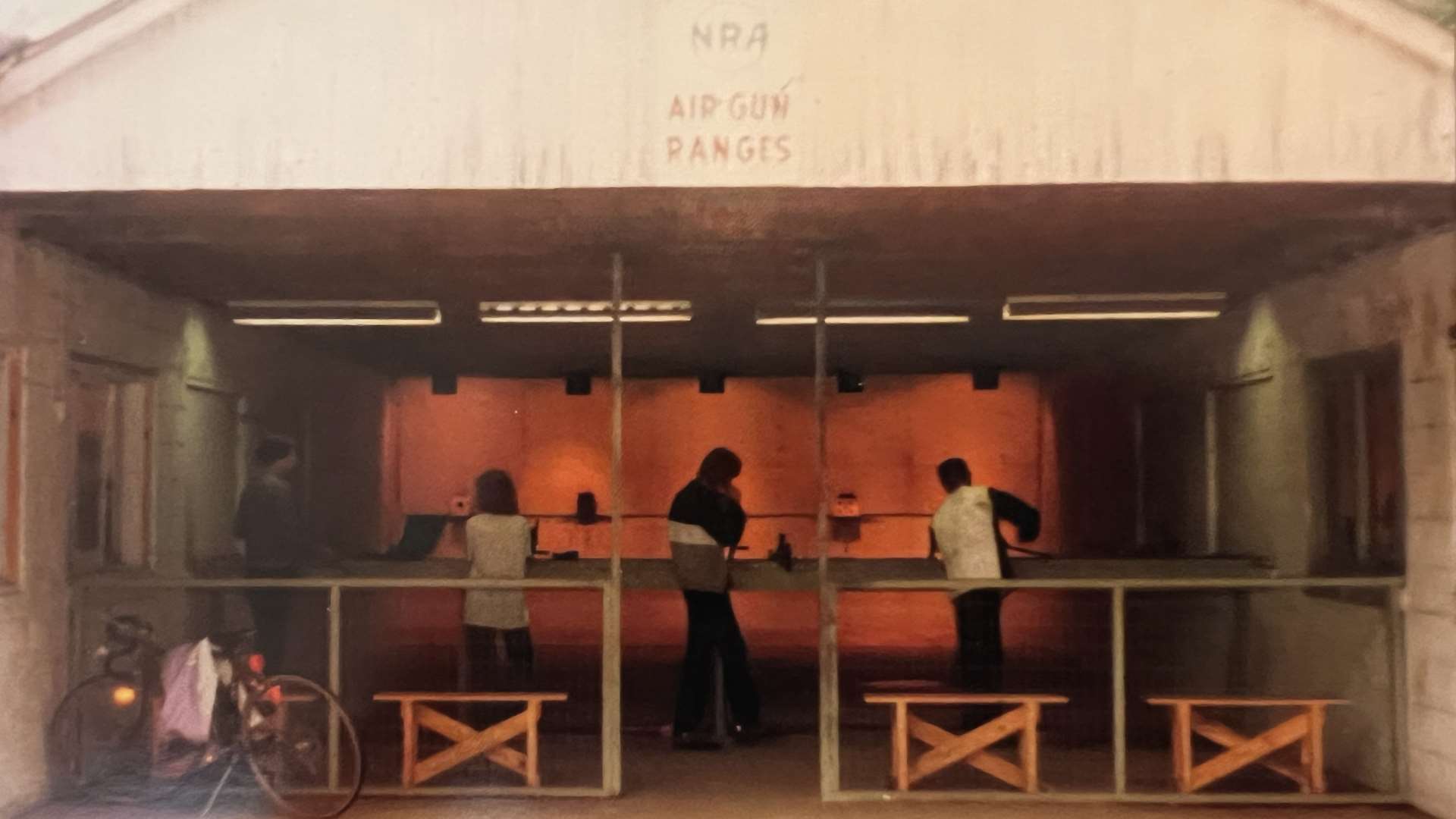
Debbie Lyman, who began her shooting career at the University of Alaska, won the women’s title while the collegiate title went to Tennessee Tech’s Jesse Johnston, the youngest member of a U.S. Pershing Team. And retracing steps they had taken many times before, Robert Makielski and Fred Cole picked up the senior and intermediate senior trophies, respectively.
When prone began, Wigger was not a reigning champion in an outdoor national smallbore championship for the first time in 12 years. His annual quota of championships was usually wrapped up by the end of position and a prone win was considered icing on the cake. Not so in 1984, although the challenge Wigger faced allowed him to showcase his extraordinary skill, formidable mental focus and exceptional competitive spirit. After an early show of force and the metallic sight championship with a 3199 effort, Wigger dropped just two more points in any sight to finish with a field-topping 6397, four over runner-up and Army teammate Brad Carnes. In third place was civilian champion Presley Kendall, who now shared the record for most National Match prone wins (four) with the new champion.
Marsha Beasley repeated as women’s champion while Joe Barnes and Ron West maintained the pattern and successfully defended their own titles in the senior and intermediate senior categories, respectively. Jesse Johnston became the first collegian to win both position and prone in the same year and Web Wright, III, captured the top junior honor.
David Tubb returned to the high power scene at Camp Perry in 1984 after a several year absence and this year he pronounced his return with phenomenal shooting, a national title and a quest for perfection that would inevitably earn him National Match elite status.
Tubb set the tone from the start as he won both the Vandenberg and Nevada Trophy Matches with a custom rifle he built himself—a post-1964 Winchester 70 with Hart barrel chambered in .308 Winchester with an Anschutz trigger. Were it not for poor weather on two of the firing days, he would have most likely broken the record score of 2377-119X set by Pat McCann the year before because despite the conditions, Tubb finished just eight Xs shy of the mark, 14 points ahead of Franklin Behl while McCann placed third.
Tubb’s breakthrough appearance as national open champion coincided with the seventh title by Noma McCullough, whose domination of the women’s game was nearing an end as she became more involved as a shooting mentor. Though McCullough would claim another title this decade (1988), a successor was in the wings, ready to carve her own niche in National Match history. Former junior and women’s champion Nancy (Clark) Gallagher, who hadn’t competed at Camp Perry from 1980 through this year, was hungry and poised for her own breakthrough.

Marine Corp. Thomas Gilbert won the service title by one after steadily gaining points over the course of the championship while defending service champ, Army Capt. Dave Erickson, opened the program with impressive dual wins in the individual Board events, becoming just the second shooter in National Match history to accomplish the feat. Ironically, the first occurrence took place just the previous summer when Greg Strom earned both victories in the same year. Erickson won the President’s Match with a course record 298-12X before pulling away from the competition in the 600-yard stage of the National Trophy Individual Match.
In the Board team events, the Marines came through in force, upping the National Trophy Team record score by six while All-Guard shooters won the National Trophy Infantry Team (NTIT) Match by an 86-point margin. Since the reintroduction of the NTIT event in 1978, the Virginia state team had won the civilian Leatherneck Trophy award, but this year the prize changed hands when Arizona topped the category.
Rare dual victories in back-to-back National Match programs were not isolated to Board events. The 1984 tournament closed out with long-range competition and service rifle victories for Marine Maj. Walter Smith in both the Porter and Farr Trophy Matches. Smith joined the Army’s Billy Atkins from the year prior as the only two shooters to claim both titles in the same year.
The any rifle counterpart to the Farr is the Wimbledon Cup Match, which in 1984 went to Army Capt. Hugo Adelson. The Leech Cup Match, fired concurrently with the Porter Match, was won by Army Spl. Jeff La Rosa with a magnum bolt gun. La Rosa had finished a close second the day before in the NRA service rifle championship and also fired on the teams that won both 1,000-yard NRA team events, the Romanian and Herrick Trophy Matches.
1985 National Matches Fact
Former NRA President and Executive Vice President Harlon Carter participated in all three shooting disciplines over the course of his life. He shot pistol with Charles Askins on the U.S. Border Patrol team before World War II and also took part in high power and smallbore prone championships.
The year 1984 marked Carter’s 50th anniversary at the National Matches as both a shooter and a match official and in celebration, he competed in the smallbore prone championship where the statistical office acknowledged the milestone by assigning him to point number 50.



